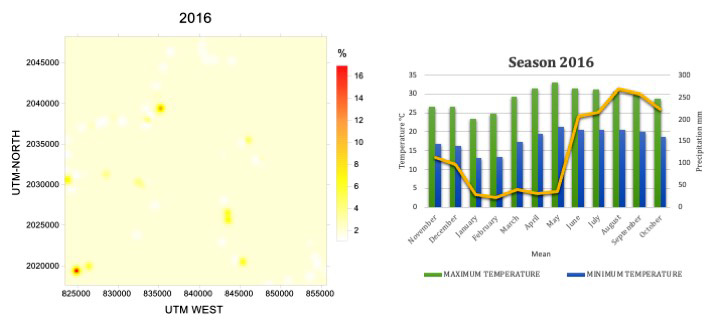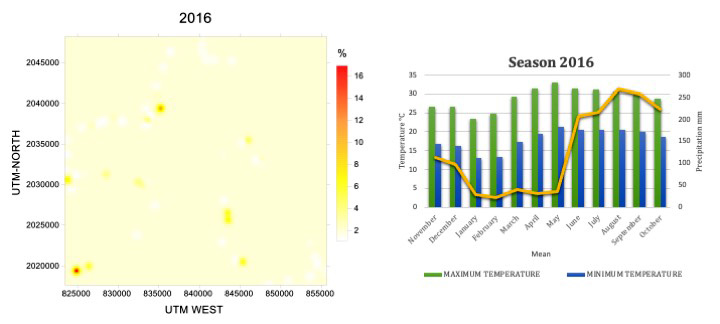Spatial pattern of mottled stripe disease (Herbaspirillum rubrisubalbicans) in sugar cane
DOI:
https://doi.org/10.48162/rev.39.089Keywords:
Bacteria, Incidence, Spatio-temporal distribution, Saccharum spp.Abstract

Sugar cane (Saccharum spp. hybrids) is the most important agroindustrial crop of the tropics. Recently, sugar cane plants with chlorotic leaf streaking associated with the bacterium Herbaspirillum rubrisubalbicans have been observed. This disease impacts photosynthetic capacity and yield. Characterizing the spatio-temporal behavior of chlorotic mottling using prediction maps is an important element of integrated disease management. Here, we determine the spatial distribution of mottled stripe disease in sugar cane in southeastern Mexico. To do this, we randomly chose and georeferenced 80 points in commercial plots in 2016 and 2017 to determine the disease incidence. We generated an experimental semivariogram based on a predetermined theoretical model and estimated Kriging. The incidence was 2.93% in 2016 and 5.36% in 2017 in varieties ICP-MEX-92-1420, CP-72-2086, ITV-92-373, MEX-79434 and MEX-69-290. The spatial behavior of the bacteria fit the pentaspherical model in 2016 and the spherical model in 2017. Spatial interpolation was validated by Mean Error (ME), Root Mean Square Error (RMSE) and Mean Standardized Prediction Error (MSPE) values near zero, visualized using the generated map. The results will be used to guide management of mottled stripe disease in sugar cane in the affected area.
Highlights
- H. rubrisubalbicans can persist from sugar cane growing season to the next and spread from one plot to another by different mechanisms.
- The chlorotic mottling of sugar cane showed an aggregate type spatial behavior at the regional level.
- The differences in spatial patterns between seasons show the dispersion potential of the disease in this crop system, as well as a latent infestation in the area.
- The semivariograms and maps show aggregate behavior of this disease, expressed as different spatial patterns given by the spatial dependence among points and the severity of the effects in each plot.
Downloads

Downloads
Published
How to Cite
Issue
Section
License
Copyright (c) 2022 Revista de la Facultad de Ciencias Agrarias UNCuyo

This work is licensed under a Creative Commons Attribution-NonCommercial-ShareAlike 3.0 Unported License.
Aquellos autores/as que tengan publicaciones con esta revista, aceptan las Políticas Editoriales.










.jpg)




